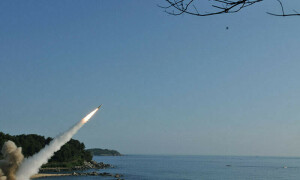MOSUL: At least 26,000 people have fled in the 10 days since Iraqi forces launched a push to retake western Mosul, where the militant Islamic State (IS) group put up “fierce” resistance on Wednesday.
Western Mosul is the group’s last urban bastion in Iraq, and its recapture would mark the effective end of the cross-border “caliphate” its leader Abu Bakr al Baghdadi announced from a mosque in the city more than two years ago.
Iraqi forces have yet to advance deep into western areas, but the fighting combined with privation and harsh IS rule has already pushed a growing number of civilians to flee.
Field teams received “26,000 displaced people from [west] Mosul during the past 10 days”, Jassem Mohammed al Jaff, the minister of displacement and migration, said in a statement.
The number who have fled is only a fraction of the 750,000 people who are believed to have stayed on in western Mosul under IS rule, but it is expected to rise sharply in the coming days and weeks.
A commander in the elite Counter-Terrorism Service said on Wednesday that IS put up tough resistance in the Maamun Flats area of southwest Mosul, which he said is considered “important for the control of the surrounding neighbourhoods”.
“The resistance is violent and fierce because they’re defending this line and this line, in our opinion, is the main line for them,” Lt Gen Abdulghani al Assadi said.
Iraq’s Joint Operations Command announced later in the day that CTS had recaptured Maamun Flats.
The damage in the Maamun area is heavy, with homes destroyed, roads cratered and rows of crumpled cars, some of them piled one on top of another.
Fleeing residents spoke of dire conditions inside the city.
“We’re so hungry, we haven’t eaten almost anything in four days,” said Widaa, a 20-year-old who fled Maamun. “There was firing all around our house, it was being destroyed bit by bit,” she said.
The drive to retake the west of Mosul — the smaller but more densely populated side of a city split by the Tigris River — began on Feb 19, after Iraqi troops retook its eastern side the previous month.
Civilians targeted by snipers
Sniper fire is a significant danger in Maamun, said Kathy Bequary, the executive director of NYC Medics, a group providing emergency care from a mobile clinic.
“We’re seeing a lot of serious gunshot wounds from snipers,” Bequary added.
“Most of our patients are combatants, but civilians are affected too. Two days ago, we treated a family — a mother, father, son and daughter — who were trying to escape Mosul and were targeted by snipers,” she said. “The five-year-old daughter was shot in the pelvis, a through and through wound. The girl was very, very critical.”
IS overran large areas north and west of Baghdad in 2014, announcing a “caliphate” incorporating swathes of Iraq and Syria.
While security forces initially performed dismally, they have since retaken most of the territory they lost, with backing from US-led air strikes and other support.
IS has also lost significant ground in Syria, and while it still holds the city of Raqa in that country and some territory in western Iraq in addition to in Mosul, the militants’ “state” is crumbling.
The operation to retake Mosul was launched on Oct 17, involving an array of sometimes rival security forces and paramilitary groups.
But the brunt of the fighting has fallen to the CTS and the interior ministry’s elite Rapid Response Division.
Published in Dawn, March 2nd, 2017










































Dear visitor, the comments section is undergoing an overhaul and will return soon.